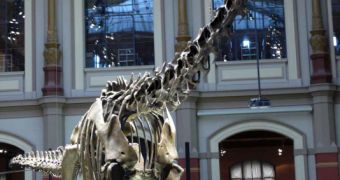Latest paleontology studies showed that, in all likelihood, dinosaurs from the sauropod class were incapable of chewing their food before swallowing it, as evidenced by their long neck, which would have been too frail to sustain the massive weight of a head full of teeth. In fact, the skull was the lightest part of their body, which was necessary in order for mammals such as diplodocus and brachiosaurus to reach the high canopies they fed upon.
Because they weighed up to about 88 tones (80 metric tones), sauropods had to consume vast quantities of vegetation in order to survive. Scientists believe that they traveled in large packs, completely stripping entire areas of vegetation before moving on. Because they had nothing to chew leaves with, they probably swallowed everything at once. The food was then processed in their impressive stomach and it is believed that they used to ingest rocks, which would grind the food directly in their gut while moving, thus eliminating the need for chewing with their mouths.
Apparently, besides their weird eating habits, sauropods were also warm-blooded, tough they laid many eggs each year. Due to this combination, their population could recover quickly in the event of a natural disaster and their numbers would grow considerably each year. They also needed to attain their maximum size as soon as possible and studies suggest that it only took about 20 to 30 years for a 22 pound (10 kilograms) new-born to become a 220,000 pound (110,000 kilograms) "grown-up."
The influence undigested food had on their internal organs must have somehow triggered their impressive growth patterns. Predator menace also could have played an important part in their evolution, given that all smaller herbivorous dinosaurs had to face blood-thirsty meat-eaters such as the Tyrannosaurus Rex. Their size could have very well been some sort of defense mechanism, an adaptation to the environment. So far, paleontologists were unable to come to a conclusion regarding what caused a specific class of dinosaurs to grow so large. New discoveries could someday shed some light on the real reasons they grew to be about 7 meters (22 feet) high.

 14 DAY TRIAL //
14 DAY TRIAL //